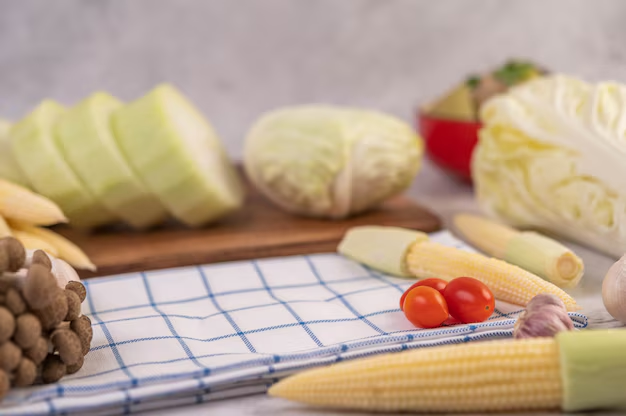How to Keep Your Corn Fresh: Insider Tips on Refrigerator Storage
Fresh, sweet corn is one of the highlights of summer, offering a burst of flavor and a healthy dose of nutrients. But what happens when enthusiasm leads you to buy more than you can consume right away? Understanding how long corn stays good in the refrigerator is essential for maintaining its quality and preventing waste. Let's dive into the details of corn storage and learn how to maximize its shelf life.
🌽 The Lifespan of Corn in the Fridge
When stored properly, corn on the cob can typically last up to five days in the refrigerator. However, this depends a lot on several factors, such as the freshness at purchase, the storage method, and the condition of the corn upon buying.
Factors Affecting Corn Freshness
Buying Fresh: The fresher the corn when you purchase it, the longer it will last. Look for corn with bright green husks and moist, sticky silks. The kernels should be plump and arranged in tight rows.
Storage Conditions: Corn should ideally be kept in the coldest part of your refrigerator, typically in the crisper drawer. This helps maintain the right humidity level, keeping the corn fresh and juicy.
Husk Removal: Deciding whether to store corn with or without its husk can impact its shelf life. While husks help retain moisture, they can also harbor bacteria. For maximum freshness, some prefer to remove the husk, while others leave it on until they're ready to cook.
Signs Corn Has Gone Bad
- Discoloration: If the kernels have turned dark or have dark spots, it's a sign of spoilage.
- Texture Changes: Withered, mushy, or slimy corn kernels suggest that your corn is past its prime.
- Off-Smell: Fresh corn has a mild, sweet scent. If it smells sour or rotten, it's best to discard it.
🌟 Storage Techniques for Extending Corn's Freshness
Storing corn effectively requires more than just placing it in the fridge. Here are some tailored strategies:
1. Keep It Whole
- Leave the Husk: Storing corn with the husk intact can lock in moisture, keeping the kernels tender for longer.
- Minimize Air Exposure: Wrap the entire corn in a plastic bag or cling film to prevent air and moisture loss, which helps reduce drying.
2. Prepped Corn
If you prefer to clean and prep your corn right away:
- Husk and Silk Removed: You can remove the husk and silk and store the de-husked corn in airtight containers or Ziploc bags.
- Use Moisture Barriers: Adding a damp paper towel inside the storage bag or container helps maintain humidity and prevents the corn from drying out.
3. Go the Extra Mile with Blanching
Blanching corn before refrigerating can slightly enhance its shelf life:
- Blanching Process: Quickly boil the corn for 3-5 minutes and then plunge it into ice water to stop the cooking process.
- Cool and Store: Dry the corn thoroughly before wrapping and storing it in the fridge.
🔍 Beyond Refrigeration: Exploring Other Storage Options
Sometimes, refrigerating isn't enough or doesn't fit your needs. Here are additional storage ideas for your corn:
🧊 Freezing Corn
Freezing is a great long-term storage solution:
- Whole or Cut Kernels: Corn can be frozen either whole (still on the cob) or as individual kernels. Whole corn should be wrapped tightly to prevent freezer burn.
- Pre-Freeze Steps: Blanching is essential before freezing to preserve flavor and color. After blanching and cooling, pat the corn dry.
- Storage Tips: Ensure to use freezer-grade bags for long-term storage, and label with the date for inventory management.
🌾 Canning Corn
Canning is another method for preserving corn:
- Step-by-Step: Canning corn involves shucking, cutting off kernels, and processing in a pressure canner to ensure safety and longevity.
- Why Choose Canning?: Ideal for creating ready-to-use produce that just needs to be heated before serving.
🌞 Drying Corn
Less common for fresh corn, drying involves removing moisture to preserve:
- Method: Use a dehydrator or your oven on low heat.
- Usage: Dried kernels work well in soups or as a crunchy snack after rehydration.
📌 Quick Reference: Corn Storage Tips
Here's a handy summary to help you keep your corn fresh and tasty:
| Storage Method | Best For | Shelf Life | Notes |
|---|---|---|---|
| Refrigeration (whole) | Immediate use | 3-5 days | Keep with husk or wrap tightly in a bag. |
| Refrigeration (prepped) | Quick cooking | 3-5 days | Store kernels in airtight containers. |
| Freezing | Long-term storage | 6-12 months | Blanch first; use freezer bags. |
| Canning | Shelf-stable pantry option | 1-2 years | Requires pressure canning for safety. |
| Drying | Non-perishable backup | Several months to years | Ideal for soups or snacks. |
🌐 Corn and Seasonal Cooking: When and How to Enjoy
Corn is a staple across various culinary traditions, and knowing when it's in season can enhance your meal planning.
Seasonal Tips
- Peak Season: Corn is at its best during the summer months. This is the time to buy, cook, freeze, and can for later use.
- Seasonal Dishes: Utilize fresh corn in salads, soups, and grills during peak season, while frozen or canned options work well in off-peak times.
Creative Uses for Corn
- Fresh: Grilled corn on the cob or a zesty corn salad.
- Frozen/Canned: Add to winter soups, stews, or casseroles for a burst of summer flavor.
- Dried: Use as a crunchy topping or rehydrate for salsa.
Keeping corn fresh and ready to eat is all about the right storage strategy. Whether you refrigerate, freeze, or decide to get into canning, each method has its advantages. Not only does this guide empower you with the knowledge to extend the freshness of your corn, but it also opens up a world of culinary possibilities.
